FRATF Discusses Roads/Culverts/Revenue Options
The Future Revenue Analysis Task Force (FRATF) met on Monday, April 10, 2021, at 9:00 a.m. to discuss Street Department needs and possible revenue options. Committee members attending the meeting in person, left to right: Rolland White, Larry Siener, Keith Keck (Vice-Chair, at the head of the table), Cathie Moeller, Phil Michaelson, and Keith Broach. The people on zoom are Jeff Lofgren (Chair); Connie Shoemaker, and Pam Avila (HSVPOA Board Member).

Guests attending were Maxine Klein, Suzanne Sweeten (Hot Springs Village Voice), Chuck Alvord, Melinda Alvord, Janet Rowe (Chair of the Architectural Control Committee), and Bruce Caverly (Chair of the Common Property, Forestry and Wildlife Committee.)
Also attending was John O’Brien (Former Director of the Hot Springs Village Greater Area Chamber of Commerce). John has recently retired from the Chamber so he can have more time to pursue other interests.
Steps in the FRAT Process
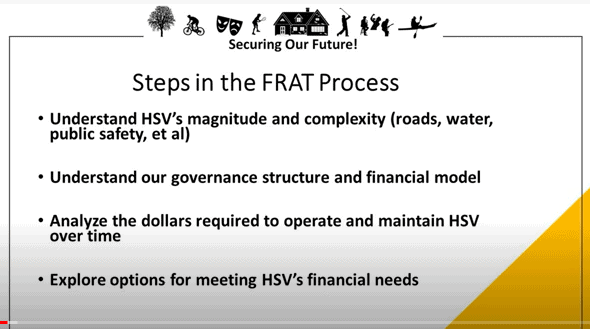
Lofgren said the task force has been working over the past few months to “understand the magnitude and complexity of Hot Springs Village.” FRATF has been working closely with the Finance and Planning Committee and also to understand the Governance of the Village.
Data Analysis – What Has Been Done

Siener said they are building a model to project future revenue and costs. This was a lot of work for the POA staff as they made over 1,800 different entries, looking at revenue sources, operating expenses, and capital expenditure requirements for the next five to seven years. Approximately 50 staff members were involved with this process and they answered over 250 questions from FRATF. Staff rated future investment priorities as:
- High Priority – Investments we must have
- Medium Priority – Some flexibility regarding timing, but these items will eventually need to be addressed
- Low Priority – Items which can be deferred, but will still have an impact
There is a difference between capital expenditures and operating expenses, explained Siener. “A capital expense is any kind of cost associated with procurement of, maintenance of, and improvements to the fixed assets of an organization.” An example of an operating expense is the cost of cleaning the bathrooms. An example of a capital expense would be a roof repair.
FRATF reviewed every department, meeting with department heads for up to three hours.
Data Analysis Example 1: Streets
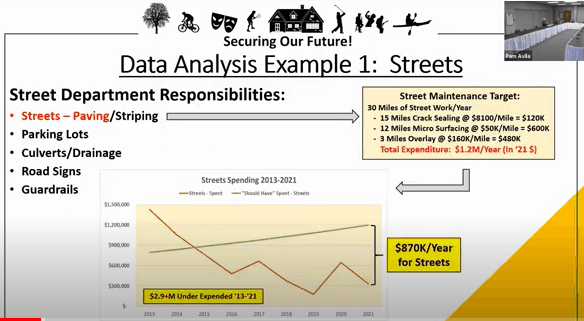
The Streets Department has a 30-mile street target every year. There are 472 miles of paved roads, with 110 miles classified as inactive (paved roads with no homes). In a 12-year time period, all active roads are “touched.” Fifteen miles of road are targeted for crack sealing at the cost of $8,100 a mile for material and labor. Twelve miles of road are targeted for micro-surfacing at the cost of $50,000 a mile. Micro-surfacing involves putting down a thin layer of asphalt with a sealer. Three miles of road are targeted for mill and overlay. Click here to see a YouTube video that explains mill and overlay. The mill and overlay procedure costs $160,000 a mile. This adds up to 1.2 million dollars expense a year for Village road maintenance.
In 2013 and 2014 the Streets Department spent what amounts to in today’s dollars 1.2 million (approximately). From 2015 to 2020 we have been under-expended by about 2.9 million dollars. This is an example of a deferred maintenance item. “The 2.9 million number actually takes into account the over expenditures in ’13 and ’14,” stated Seiner. “The number from ’15 on is actually worse than 2.9 million dollars.”
Keck said, “in reality, the over expenditures in 2013 and 2014 were not really over expenditures. That was trying to catch up for probably 10 years of prior street challenges we had. Decisions had been made in that early ’11, ’12, and ’13 time frame to try to fix streets and you saw a lot of paving going on, but it was diverting money from other places, and then finally, there was no other money to divert there.”
Why use contractors for some jobs?
Siener said they monitor social media. “We don’t necessarily respond to it, but we monitor it. There is a lot of chatter on social media regarding the usage of contractors versus the usage of POA staff. You typically use contractors for one of two reasons. Either you don’t have the equipment or the expertise or something of that nature to be able to execute that task or you are doing it for staff augmentation because you don’t have the human resources to do the job.”
Data Analysis Example 2: Culverts
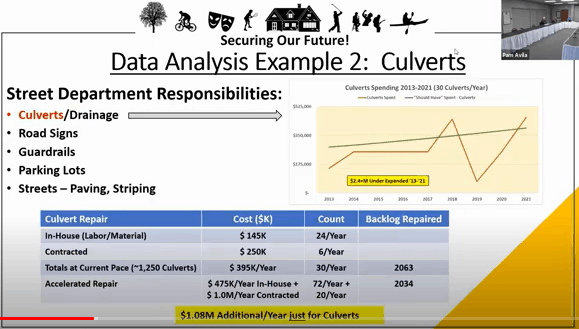
Some culverts are replaced using in-house staff, while others require using an outside contractor. The in-house team can handle the smaller culverts and/or the culverts which are shallowly placed underground. Some of this work involves “sleeving” the existing culverts.
In ’20 and ’21 we are spending about $145,000 a year with in-house labor and materials to do culvert repairs. Today we have only one five-man street crew. We are repairing 30 culverts a year but have a backlog of about 1,250 culverts that still need repair. There are more than 3,900 culverts in the Village. At our current pace of 30 culverts a year, the existing backlog would not be completed until 2063.
The Street Department proposed an accelerated culvert repair program which would involve hiring two additional four-person street crews. This would increase our in-house spending to about $475,000 a year and increase the culvert repair rate to 72 culverts per year (internal work). “We would then have to bring in additional money to the contractors’ side of the house at a million dollars a year at $50,000 per culvert, which would repair 20 additional culverts per year,” said Seiner.
Increasing our in-house crews and contractor repairs would catch up the existing backlog by 2034. Realistically, the culverts will continue to fail and this is an ongoing process.
The Streets Department is looking at three different culvert techniques.
- Traditional corrugated metal
- Reinforced concrete pipe
- Sleeving material (composition plastic)
Synergy Between Culvert Repairs and Street Repairs
Culvert repair impacts street repair. Ideally, you have a culvert and street repair that are aligned. When you are working on a road, you address the culverts at the same time. This eliminates tearing up freshly overlaid roads in order to replace a culvert.
The Streets Department would like to do a road study using ground-penetrating radar to help them understand what repairs are needed and to further refine the culvert and road repair program.
Final Data Point: Street Department
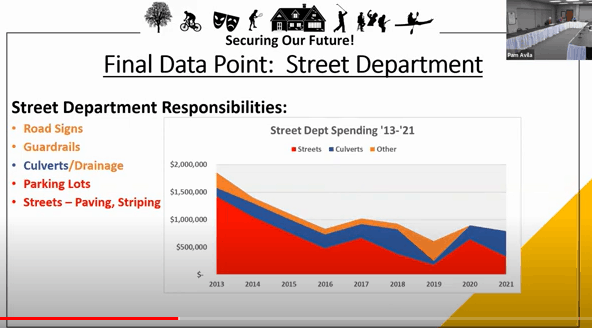
The Street Department is replacing legacy signs with retro-reflective signs with larger lettering. When your car lights hit the new signs it reflects back so it is easier to see.
Additionally, the Street Department repairs damaged guardrails. Also, because some roads have been repaved a number of times, the street is higher than it was originally and some of the guard rails are too low for high-profile vehicles. The crews are identifying these guardrails and raising them.
Culvert repairs cannot be done when the temperature is too cold for the roads to be repaired. The asphalt will not cure properly.
Drainage work is typically done in the colder months.
Data Roll Up: Street Department
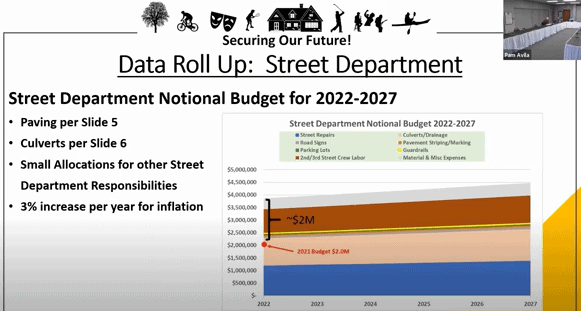
The above slide is a notional budget for the Street Department for 2022 – 2027. The lines are projected upward at the rate of three percent inflation per year. “In 2022, the budget demands are on the order of 3.9 million dollars. The 2021 budget was just a hair over two million dollars for the Street Department,” explained Siener.
For the Street Department, repairing/replacing the culverts and road repair are their most expensive items, but other items such as sign replacement, etc. still need to be addressed.
Increasing the pace of road work/culvert repair will also increase our fleet/equipment/tool costs.
Options Development Status


Keck said numerous ideas and documents from the community have been submitted to the task force.
Option Requirements
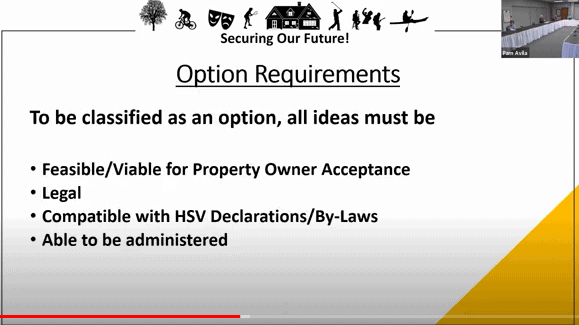
Options were considered and a determination was made as to feasibility, legality, compatibility with our governing documents, and ability to be administered.
The Options Working Group met on Friday, May 7, 2021, with some of the committee chairs. They discussed more than 60 ideas on the list.
Ideas Analyzed That Did Not Meet Criteria
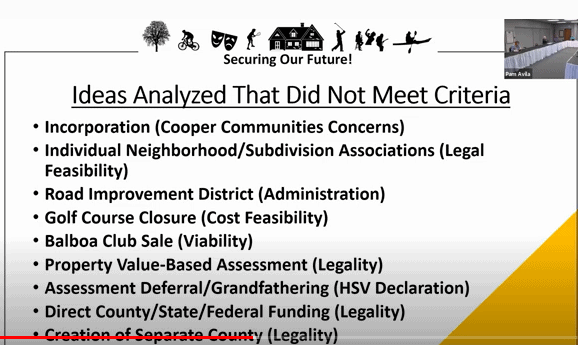
Incorporation
CCI would like to see this as the last resort. Keck said, “they are really proud of Hot Springs Village and they went through the experience of Bella Vista and have asked us to not go this way if at all possible. As this idea was looked at by the Governmental Affairs Committee back in the 2011/2012 time frame, this is a major undertaking and it is above the expertise of anybody sitting in this Village…This would be asking for outside help to do this properly. We are putting this off to the side right now. We hope we don’t have to go that way.”
There are two voting classes and CCI has veto power. Keck said, “when it gets to a corporation, we get to a whole different world there for who votes on what and how it is done. He has some influence on voting and he does not have some influence on voting because you start talking Property Owner voting versus Registered Voter voting and that person who rents here, is probably a registered voter. He has a different influence than a Property Owner. It is a very complicated issue. And again, it comes down to Cooper really. They developed this 50 years ago as a private community and they would like this…There are so many other interconnected things with Cooper Corporation. We’re looking at putting that aside right now as far as meeting the criteria.”
Individual Neighborhood Subdivision Associations
We already have this with the Townhouse Associations and Diamante. “This is legal and could be done, however, the ability to do that under our Declarations will be very, very interesting. What I am saying here is that if Isabella Golf Course wanted to develop their own subdivision association, the way our Declarations are written, it’s not as easy as you think…The lawyers have looked at this and said it is doable, but it is not easy,” said Keck.
Road Improvement District
This can be done but is usually done at the beginning of a development. A developer controls the requirements needed. You need the majority of the voters, acreage owned and the authority of the assessed value to all agree. This is easy at the beginning of a development, but becomes much more difficult later on.
Improvement Districts are formed via county, so you would need both a Saline and Garland County Improvement District. You would need separate commissioners so administration would be a challenge.
Separate entities would be needed to oversee the Improvement Districts. This would not be our current Board or POA. This would add to the complexity of who’s in charge of what.
White said, “the roads go back and forth between counties and this would be very, very difficult.”
Golf Course Closure (Cost Feasibility)
Keck said, “we have touched base with the commercial real estate folks and the county accessor’s office and specifically the appraisers… if we went down the road of golf course closure, what would be an estimate of impact…specifically impact of values of the houses or lots on the golf courses?”
Saline County Golf Courses – unimproved lots are still valued at $15,000. Today they are selling for close to $50,000. The appraiser said if you turn the course into green space, you are looking at a decreased value of $10,000. For improved lots, you are looking at a minimum of $20,000 decreased value. For the smallest golf course, it would cost 2.5 million dollars in payout, not taking into account legal costs or other costs. For the bigger golf courses, this payout could cost over 5 million dollars.
Closing golf courses would cause a problem with public relations, legal problems, and financial pain. Right now the Task Force is setting this option aside.
Sale of Balboa Club
The POA leadership is looking at options for usage of the Balboa Club. The Task Force is setting this option aside.
Property Value Based Assessment
The legal opinion from Rose Law Firm says our Declarations do not allow this. We can change this with a Declaration vote in five years. CCI does not favor this option.
There is a “reasonableness test” and the attorneys felt this would not be doable under current arrangements.
Assessment Deferral/Grandfathering
Keck stated, “we understand. And this discussion came up seven years ago. We may have people that cannot afford an assessment increase. They are living on fixed incomes…” FRATF asked Rose Law Firm if an assessment deferral was possible. The attorneys said that the way our Declarations are written, no you cannot defer someone’s assessment because it takes the Property Owner out of good standing. They would lose their rights to our amenities.
As long as we can keep people in good standing, there may be other available options out there such as a church sponsoring one of their members or some other sponsoring organization. The obligation for the Property Owner would be to another outside agency.
Direct County/State/Federal Funding (Legality)
At Friday’s Governmental Affairs Committee Meeting (May 7, 2021), Senator Bill Sample said that we are a private gated community and the public does not have access so we cannot receive these types of government funds.
Keck stated, “we know how much money we pump into the state and county, but at the same time we only have three representatives that fight for us (Fite, McGrew, and Sample). They are a minority in the state.
FRATF is still looking at grant options for the police department. As long as the police department supports the surrounding area either in training or otherwise, this may be an option. There are potentials there. This is also an option for the Fire Department. (833 Funds)
Creation of a Separate County (Legality)
Our size excludes this possibility. In order to do this, we would have to annex land from outside the village to meet the size requirements. We have 26,000 square acres, but need 600 square miles to have a new county in Arkansas. Our square mileage is only 30 to 35.
Gate Issues – Some of the above ideas would necessitate opening up the roads. Incorporating and maintaining the gates would be a challenge. If you opened up Desoto Boulevard for state and county funding, you would need 76 gates along the way to keep everybody gated. This would mean all the truck traffic would be traveling on Desoto.
Ideas Still Under Consideration
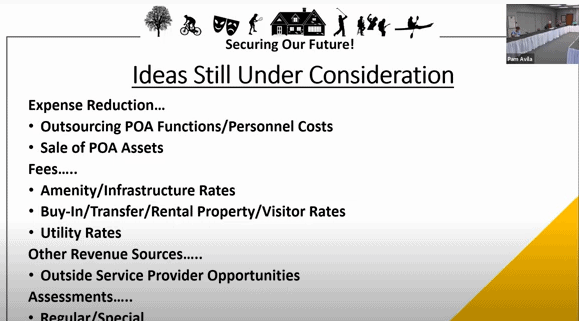
Expense Reduction…
Outsourcing POA Functions/Personnel Costs – “This is not as easy as it looks,” said Keck.
Sale of POA Assets – They took Balboa Club off the list but there are other assets that may be marketable. This would require a membership vote.
Fees…
Amenity/Infrastructure Rates – This is still being looked at.
Buy-In/Transfer/Rental Property/Visitor Rates – A buy-in (impact fee) is still being looked at. This was recommended five years ago. If this is done, it may need to be structured because we are a diverse community (pricing).
There is not a lot of money in transfer fees, but this needs to be looked at.
Some rentals are Airbnb’s and sometimes there are seven cars at one of these properties. This is a potential option. The Village is watching Hot Springs to see how they handle this.
It is one thing to bring in your family or a friend. An example of this would be that sometimes people sign in 15 different cars to go to Balboa Beach. Is that the same as someone bringing in your brother to stay at your house for the weekend?
Utility Rates – Water/wastewater increases are being looked at. Based on the last survey that was done, we are fairly compatible with surrounding area utility rates. They will take another look at this and update the numbers.
Other Revenue Sources…
Outside Service Provider Opportunities – Water and wastewater – We know that there is potential. However, there is also a challenge. “With every challenge, there may be opportunities to work together on that challenge,” Keck stated.
Regular/Special – FRATF’s goal is to present options to the Board across the areas. FRATF’s job would be easy if they just raised assessments. Keck said, “we are not looking at it as if it is the ONLY thing we are going to do.”
FRATF will do comparative analyses on what it costs to live in other places. The Village faces infrastructure challenges with rock and hilly terrain. The Village has a reserve fund now for use in an emergency, but in 2015 lacked this. A lot of our infrastructure is old and has a finite life. Some of the water lines, etc. will need to be replaced.
The POA is still looking at suspending neighborhoods so they will not be liable for bringing infrastructure into certain areas. Stephanie Heffer is in charge of this and watches the Commissioner of Land lot sales for possible lots for the suspension program.
Communications

Communications Plan

FRATF wants Property Owner Input. Please email your input to yourvoice@hsvpoa.org. Assessments cannot be raised until they are voted on.
FRATF has sent out numerous email communications to the community and also has a web page on Explore the Village. Click here to visit Explore the Village.
In May and June, FRATF will be meeting with all organizations to present the data analysis they have completed. If you have a club or organization and would like the Task Force to make a presentation, please reach out at yourvoice@hsvpoa.org. There will be Town Hall(s) in June.
FRATF has two more public meetings on June 7 and July 12 at the Ouachita room at the Woodlands. The time of meetings will be announced.
Next Steps

Timeline
May – June – roll out financial analysis
June – July – complete options analysis
July – August – brief Board
By Cheryl Dowden, May 12, 2021
* * *
Thank you for reading. If you like, please comment below. We love to hear your opinion, but comments must be made using your first and last real name, or they will not be accepted. If you would like to submit an article for publication, please contact us through this website. Be sure to bookmark this website. Click here to visit the Hot Springs Village People Facebook Group, also known as POG (Property Owners’ Group).










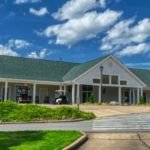
Tom Blakeman
05/12/2021 — 5:23 pm
A few impressions, based only on reading this transcript:
1. Interesting and good that they are discussing with CCI.
2. Seems as though this was only a cost review of needs for roads, culverts, etc. Good, but where’s all the other stuff?
3. Hardly a mention of cost reductions.
4. Selling sewer and water services is apparently rearing it’s ugly head again.
5. Also seems that aqueezing residents more on water and sewer rates is in the cards.
6. No mention of marketing at all.
7. No mention of increasing golf revenue or increasing course utilization from outside players.
8. Doesn’t seem like much interest in forcing repatriation of county taxes.
9. Did we actually get a written legal opinion on value based assessments? If, so it would be good to know what exactly was asked for and see the legal response published. There are many years to work on this for a property owner vote but if it isn’t started now on a parallel track it can never happen.
Perhaps I’ll have more comments after I listen to the meeting rather than just reading the transcript.
Joy Stefan
05/13/2021 — 9:34 am
This task force has tackled a monumental job, and appears to be very thorough in its approach and conclusions. Many thanks for the work they are doing, and also to you, Cheryl, for transcribing the results!